|
Dr. Zafrul Allam Assistant Professor Department of Human Resource Management Prince Sattam Bin Abdulaziz University, Post box: 165, Al-Kharj-11942 Kingdom of Saudi Arabia E-mail: z.allam@psau.edu.sa |
The present investigation was an attempt to detect the level of emotional intelligence among the employees. The sample of the present investigation comprises of 110 employees and has been selected randomly in Tania Water Company located at Al-Kharj and Riyadh region from Kingdom of Saudi Arabia. The responses were obtained from the employees with the help of emotional intelligence scale and demographical characteristics sheet. The data were analyzed by means of descriptive statistics. The paramount finding obtained in this investigation reflects that majority of the employees experienced low level of intelligence. This study suggested few mechanism to enhance the level of emotional intelligence and will trigger more comprehensive work.
Keywords: Emotional intelligence, Emotional reparation, Emotional clarity, Emotional attention
In today technological world, emotional intelligence (EI) became indispensable and can expect number of change in the next decade in the holistic transforming in the behaviour of human being which we can’t ignore. Emotional intelligence is the notion with high engrossment and well-studied in the contemporary work setup. However, the term amalgamates two words and came together to make one as “Emotional Intelligence”. Indeed, it is necessary to first understand the term “emotion”, which means “a strong feeling deriving from one's circumstances, mood, or relationships with others” and intelligence refers to “the ability to acquire and apply knowledge & skills”. Henceforth, emotional intelligence permits us to understand the emotions of self & others and act according to the situation to resolve the issues. However, the term emotional intelligence originated by Salovey & Mayer (1990). They later conceptualized the EI “as the subset of social intelligence that involves the ability to monitor one’s own and others’ feelings and emotions, to discriminate among them and to use this information to guide one’s thinking and actions”. After few years Mayer and Salovey (1997) expounded “EI is the ability to perceive accurately, appraise, and express emotion; the ability to access and/or generate feelings when they facilitate thought; the ability to understand emotion and emotional knowledge; and the ability to regulate emotions to promote emotional and intellectual growth”. But the term gained much popularity from the Daniel Goleman who introduced EI competency model which is well acclaimed by the academics and other professionals worldwide. Moreover, Goleman (1998) stated emotional intelligence “as the capacity for recognizing our own feelings and those of others, for motivating ourselves, for managing emotions well in ourselves and in our relationships”. It can be seen from the above definitions, emotional intelligence play a pivotal role to understand self, others and act accordingly.
A comprehensive reviews on various literature among personnel working in numerous sectors which signifies that EI prowess are imperative for the purpose of personal social health, performance, leadership, resilience and achievement of the goals (Goleman, 1995 & 1997; Cartwright and Pappas, 2008 and Allam, 2011). Various investigation results indicates that personal characteristics are associated directly or indirectly with emotional entelligence (Kauts & Kumar,2013; Mohan & Mohana, 2015; Joseph & Patel 2010; Kaur & Neetu, 2010; Maddocks,2011; Kumar & Muniandy, 2012; Sengupta & Jha, 2014; Bibi, 2015 and Mandell and Pherwani, 2016). Motivation, organizational commitment, job involvement and job satisfaction of employees are an essential attributes to accomplish the goals. Thereby if levels of these variables are high or low, this reflects the perception of the employees towards the direct or indirect relationships with emotional intelligence (Allam, 2007; Alavi et al., 2013; Allam & Harish, 2010; Allam, 2013 and Allam, 2017). Mavroveli et al., (2009) stressed in their investigation that individual who is more success in their social milieu because of their high level of EI and considered as better in providing support in their social life which are acknowledged by all. Ealias & George (2012) observed that emotional intelligence has positive relationship with job satisfaction which reflects that people with high level of EI required for higher degree job satisfaction. The study conducted by Ates & Buluc in 2016 and they expressed the association amongst motivation, emotional intelligence and organizational commitment in relation to the academic professionals and revealed that emotional intelligence is well associated with organizational commitment and motivation. Researcher, Sinha (2016) initiated an investigation in organised sector in India and observed that maximum number of employees showed moderate level of intelligence and lesser number of employees felt high level of emotional intelligence. However, Khan et al., (2017) conducted a study to probe the relationship of emotional intelligence with job satisfaction and found that high emotional intelligence leads to high job satisfaction. Navas and Vijayakumar (2018) reviewed various researches conducted on the globe on emotional intelligence with variables such as organizational commitment, job stress and job satisfaction. They emphasized that emotional intelligence has an impact on job stress, job satisfaction and organizational commitment based on varied findings. Allam (2019a) probed issue related to work life balance of employees in the Kingdom and his findings directly or indirectly pushing the management to understand work life balance issues which has link with emotional intelligence to improve the work performance.
The following objectives were formulated based on the review of literature: To explore employee perspectives towards emotional intelligence. To assess the level of emotional intelligence of the employees. To provide suggestions to enhance the level of emotional intelligence
Sample: The sample of the present investigation comprises of 110 employees working in Tania Water Company from Kingdom of Saudi Arabia, selected randomly to conduct the study
The emotional intelligence (EI) questionnaire chosen for this particular exploration was developed by Salazar (2017) which has been obtained from internet i.e. https://blog.cognifit.com/emotional-intelligence-test/. The instrument basically meant to know your emotional intelligence. The instrument has 24 items and all the items has been divided into three components namely emotional attention (EA), emotional clarity (EC) and emotional reparation (ER) are considered to evaluate the level of emotional intelligence. However, the instrument all the components have equal number of items and each item probing employees perception on the five point likert scale with the weighted score “Strongly agree = 5”, “Agree = 4”, “Undecided = 3”, “Disagree =2” and “Strongly disagree = 1”. Biographical information blank sheets were also attached with this instrument to get the demographical particulars of the respondents.
Data Analysis: The collected data has been analyzed by means of inferential and descriptive statistics to achieve the set goals of the investigation
Procedure and Ethics: The questionnaire distributed among employees after permission has been granted by the higher official and all the instructions were provided to them. Indeed, the precautions were taken into consideration to maintain the ethics of the scientific investigation. Respondents were informed that their responses will be kept confidential and such responses will be used for scholastic purposes.
In order to have concrete explanation towards emotional intelligence among employees working in the Kingdom, demographical variables would have been taken into consideration as well. With the help of age, gender, marital status, qualification etc., it would be better to understand the sample and its demographic characteristics which might be useful in the analysing and discussing the results of this particular investigation to have a holistic viewpoint of emotional intelligence.

It is evident from the aforesaid table that out of 108 respondents, the percent of national employees “Saudi” are 73.1 and 26.9 percent employees are international “Non-Saudi”. It reflects that Saudi employees are working more in numbers.

It is observed from the aforesaid table that out of 108, 91 (84.3%) employees are male in the company whereas, 17 (15.7%) are female. The result highlights that female are lower in number as compared to male. Scholar studied on emotional intelligence taken into consideration of gender (Singh, 2002)

It is observed from the aforesaid table that out of 108, 91 (84.3%) employees are male in the company whereas, 17 (15.7%) are female. The result highlights that female are lower in number as compared to male. Scholar studied on emotional intelligence taken into consideration of gender (Singh, 2002)

Notably observed from the above table that 79 (73.1%) were fall in the age group of 20 to 30 years, 27 (25%) were in the age group of 31 to 40 years and 41 and above were only 1.9% (N=2) age categories of employees employed in the company. Without any argue, it reflects that majority of the employees are younger in the company.
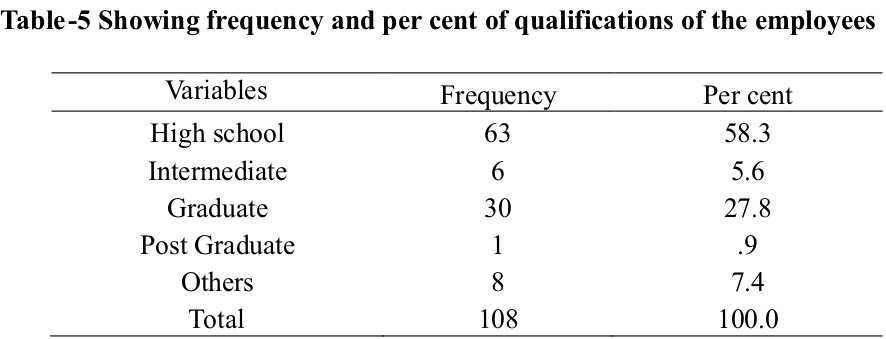
Table-5 showed the qualifications of the employees, mostly (58.3%, N=63) of the employees are having high school degree, and 27.8% of the employees are in the category of graduate qualification. Undoubtedly, it reflects that majority of the employees working in this company are not having graduate degree but entry point qualification which made them to work in the organization. However, Mohanty and Devi (2010) opined that qualification have positivity towards EI.

The above table-6 presented the family size of the employees. Some (56.5%) are 4-6 members, (26.9%) are having 2-3 members and (16.7%) are 7 & above members in their family. This indicates that majority of the employees are not staying alone

Table-7 revealed the length of the service of the employees, some (65.7%, N=71) are in the job for 1-5 years, few (29.6%, N=32) are in the categories of 6-10 years and least (4.6%, N=05) are in service for 11-15 years. This reflects that majority of the employees are not much experienced and these results are aligned with the employees’ age categories.
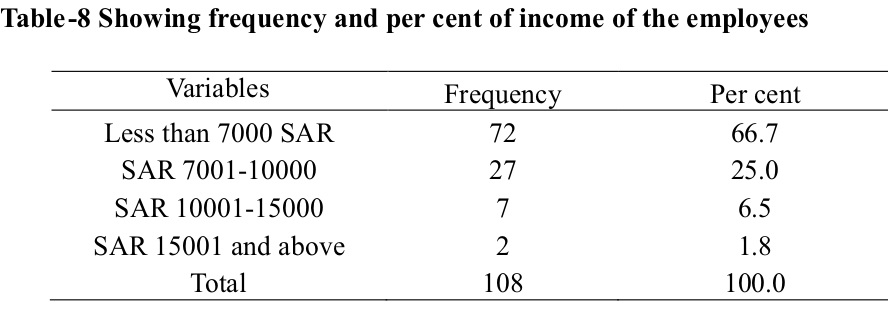
Table-8 declared the income of employees in terms of Saudi Riyal, majority of the employees are getting salary less than 7000 (66.7%, N=72), some (25%, N=27) are in the ilks of SAR7001-10000, few (6.5%, N=07) are in the categories of SAR 10001-15000 and least (1.8%, N=02) are in the ilks of SAR 15001 and above. This result indicates that large number of incumbents is getting adequate salary for their survival. Jacques (2009) explained that socioeconomic status is not vital to assess the level of emotional intelligence.
Displaying of distribution of frequency & scoring of various dimensions of emotional intelligence
This table shows that Bartlett's test of sphericity is found to have a soaring chi-square value which is significant as the value p< 0.001. It is observed that facets or factors are responsible to generate emotional intelligence (EI) among the employees. Indeed, the robust of the current investigation forced the researcher to go further for factorial analysis to check the factor responsible for accomplishment of emotional intelligence. The KMO value was .688, which indicates the significance level that might be useful to go for factor analysis. Itemises of the factorial analysis are shown in the Table-14.
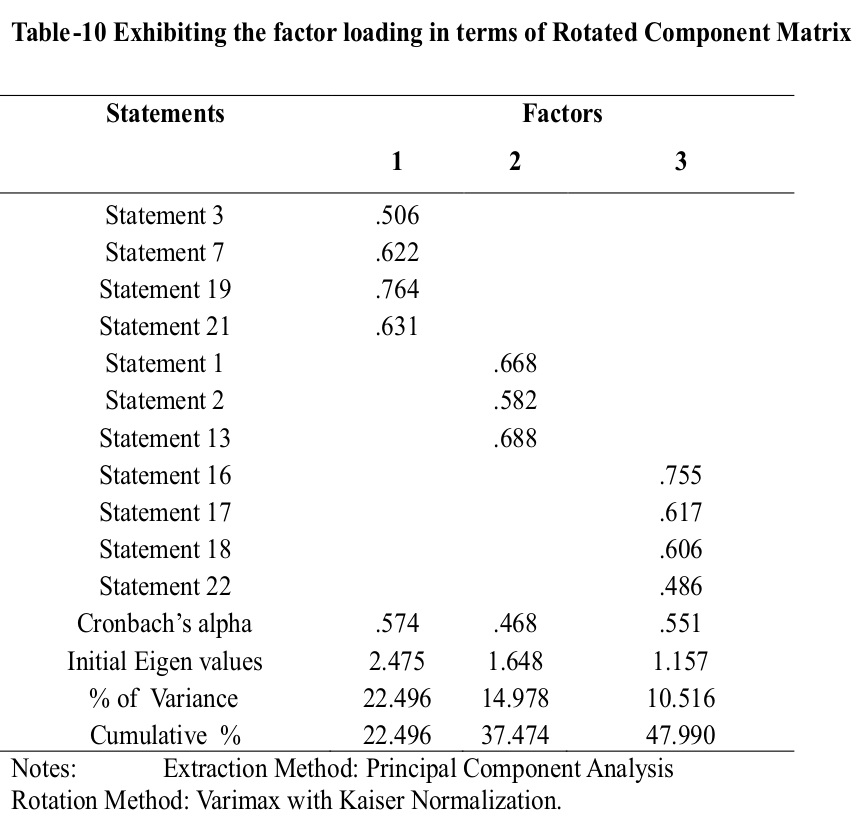
Rotation converged in 5 iterations. The scale was having 24 items; the correlation was done to eliminate the items whose score was less than 0.4 and again SPSS run to get accurate factors. It is observed that three factors obtained with Eigene values over 1.0 (1.157and 2.475) along with 47.990 per cent total variance. Ford et al. (1986) and Hinkin (1995) posited that criterion of .40 is aforethought as stipulated deciding factor loading. Further, the reliability of the scale found low and astounded that all three factors is having less than .7 alpha values which are against the acceptable value (Nunnally, 1978). Moreover, alpha value lesser than .7 or .6 is indicates of less items included in the subscale and small sample size which is observed in this investigation also. Scholars Bretz, & McClary (2014) and Griethuijsen, et al., (2014) justified alpha value which is less than .7 and provided own commentary regarding the value and whereas, Taber (2017) mentioned in his paper that acceptable value of alpha score is between 0.45–0.98.
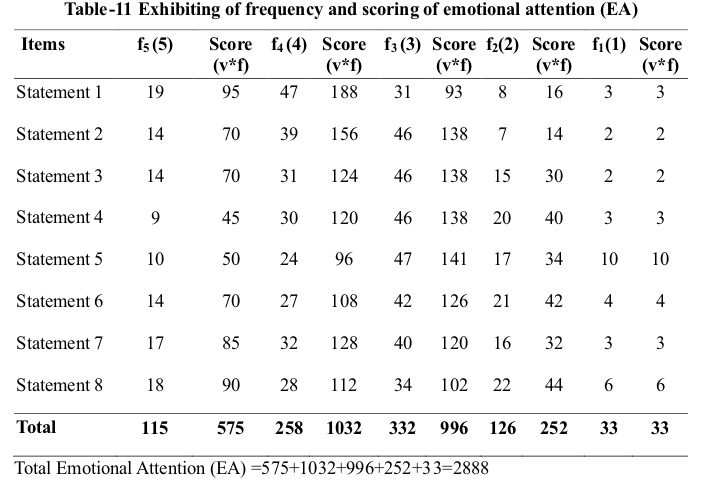
Total Frequency (∑f) =∑ f5+∑ f4+∑ f3+∑ f2+∑ f1= (115+258+332+126+33=864) Weighted Average Mean of EA (WAMEA) = ∑v*f/ ∑f=2888/864=3.34 It is observed from table-11 that total value on emotional attention score and frequency were found 2888 and 864 respectively. Further based on the formulae the calculated weighted average mean of EA (WAMEA) established 3.34. It can be attributed that majority of the employees hailed from agree responses which reflects the attention of respondents towards their feelings.
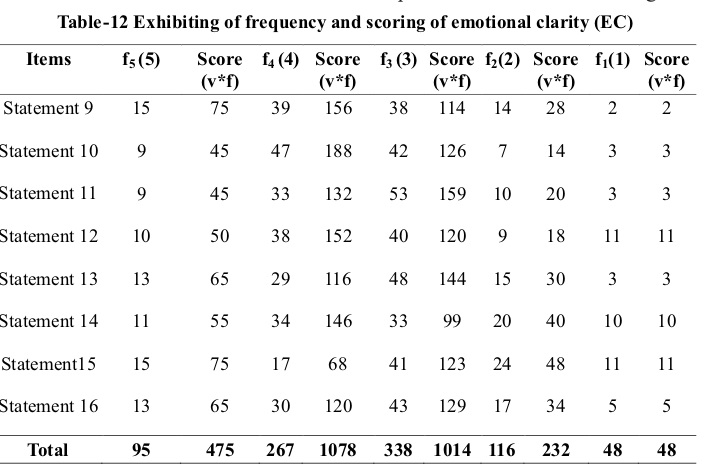
Total Emotional Clarity (EC) =475+1078+1014+232+48=2847 Total Frequency (∑f) =∑ f5+∑ f4+∑ f3+∑ f2+∑ f1= (95+267+338+116+48=864) Weighted Average Mean of EA (WAMEC) = ∑v*f/ ∑f=2847/864=3.29 In table-12, the result of emotional clarity was presented in terms of value scores and frequency. It has been seen that weighted average mean of EC (WAMEC) observed 3.29. The result of investigation indicates that incumbents are very clear about their feelings to express in any given circumstances.
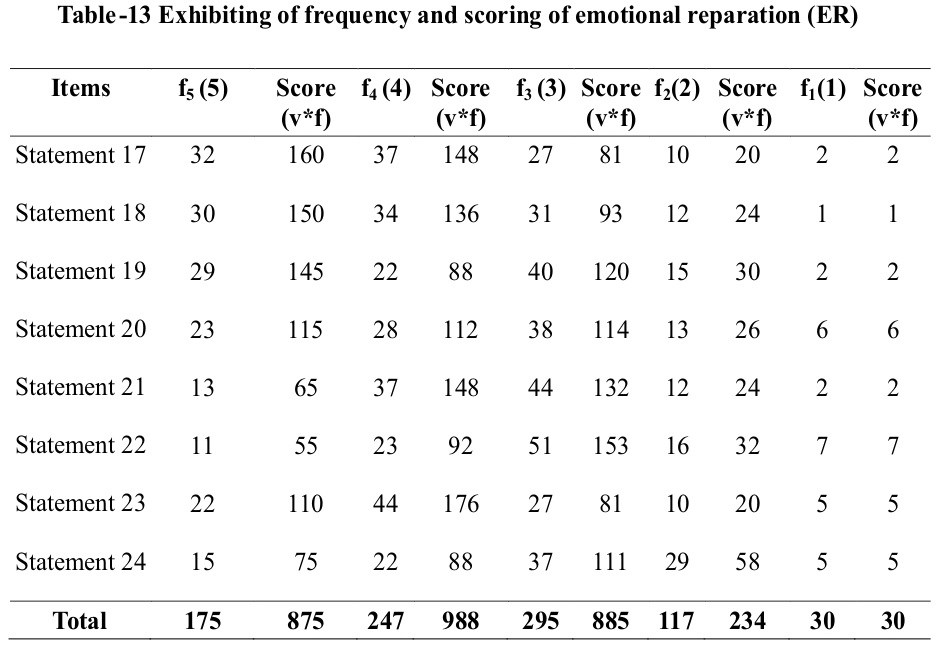
Total Emotional Reparation (ER) =875+998+885+234+30=3012 Total Frequency (∑f) =∑ f5+∑ f4+∑ f3+∑ f2+∑ f1= (175+247+295+117+30=864) Weighted Average Mean of EA (WAMER) = ∑v*f/ ∑f=3012/864=3.48 The outcomes of the present statistical techniques in the form of weighted average mean of ER (WAMER) and found 3.48. It can be interpreted that incumbents regulates their emotions as per the state of minds such as sad, anger, calm etc
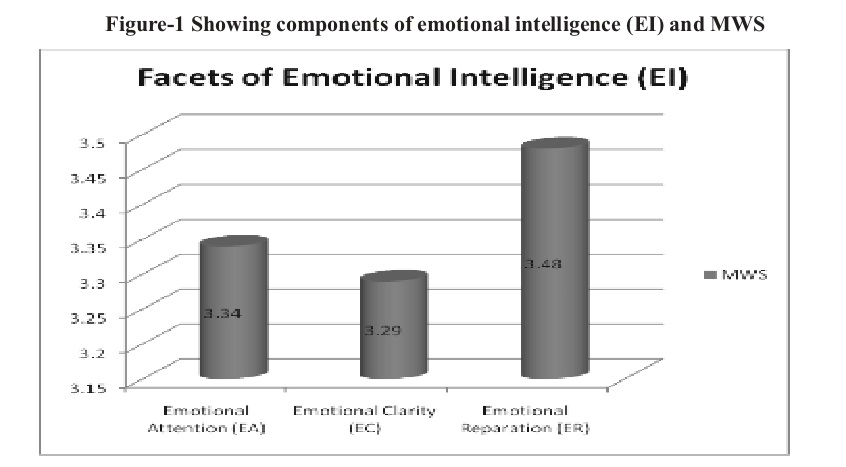
The figure-1 reveals the weighted average mean scores of three facets of emotional intelligence i.e. Emotional Attention (EA), Emotional Clarity (EC) and Emotional Reparation (ER). It is observed that most of employees have highest degree of amenity towards emotional reparation (WAMER=3.48), followed by (WAMEA=3.34) and (WAMEC=3.29).It can be attributed that clarity of emotion of the respondents is low and the reason behind is not able to understand the emotion according to the desire situations which need to address as earliest. Assay of levels of Emotional Intelligence (EI)
EI total score= EA+EC+ER Minimum Score= 24X1=24 Maximum Score=24X5=120 The range of EI will be, 24-120 The total EI will be bifurcated into three parts to examine the levels of EI.

It is observed from the aforesaid table-14 that majority of employees in the company have low level of intelligence (N=43, 39.8%), moderate level of intelligence (N=34, 31.5%) and 28.7% showed high level of emotional intelligence. It is worthy to mention that those who are having low score on EI required to be counselled, advised, suggested and trained to enhance the productivity of the organization by eliminating the negative emotions and reduced sense of personal accomplishment at workplace. It is noteworthy to provide the information that high emotional intelligence is attached with better performance and effectiveness (Cartwright and Pappas, 2008). Another researcher, Upadhyaya (2008) found that low emotional intelligence people are more apprehensive and anxious pertaining to their future, have lack of energy, feeling of failures, uninterested, restrain others and less cautious.
The following conclusions have been drawn based on the above findings: As far as demographical characteristics is concerned, Saudi, male, single, mostly young in age, less qualified,4-6 members, low level of experience and less than SAR 7000 salary employees are working more in numbers in the organization. Most of employees have highest degree of amenity towards emotional reparation (WAMER=3.48), followed by (WAMEA=3.34) and (WAMEC=3.29). Majority of employees in the company have low level of intelligence followed by moderate level of intelligence and high level of emotional intelligence.
The investigator achieved the primary objectives which have been formulated for this particular investigation. But still current investigation has certain flipside which needs to take care in the future investigation. Future studies can be incorporated by taking different psychological variables such as job satisfaction, organizational culture, job burnout, job involvement and other HRD variables to understand the affairs of emotional intelligence of the personnel and their outcomes. A similar kind of study can also be initiated with larger sample size, other more relied instruments and methods to draw better understanding of emotional intelligence. Albeit, Allam (2019 b) suggested that fair HRM practices in relation to training and development, performance appraisal, working conditions, security and health etc must be applied at the workplace to improve the performance of the employees. To align his finding, it is highly essential that management must ensure adequate assistance needed for their employees’ to enhance the emotional intelligence to perform successfully in their organization.
: The author is grateful to Mr. Abdulrahman Fahad and Mr. Mohammed Abdulaziz for their assistance in collecting the data to complete this research.
Alavi, S. Z.; Mojtahedzadeh, H.; Amin, F., & Savoji, A. P. (2013). Relationship between emotional intelligence and organizational commitment in Iran’s Ramin thermal power plant. Procedia-Social and Behavioral Sciences, 84, 815-819. DOI: 10.1016/j.sbspro.2013.06.653. Allam, Z. (2007). A Study of Relationship of Job Anxiety and Job Burnout with Job Involvement among Bank Employees. Management and labor studies, 21(1) 30-38. Allam, Z. (2013).Job anxiety, organizational commitment and job satisfaction: An empirical assessment of supervisors in the state of Eritrea. International Journal of Development and Management Review, 8(1), 50-62. http://www.ajol.info/index.php/ijdmr/article/view/91299 Allam, Z. (2017). Intrinsic and extrinsic motivation: An empirical tale of employees looks in a job. Research Journal of Applied Sciences.12 (2), 117-124. Allam, Z. (2019a). An inquisitive enquiry of work-life balance of employees: Evidences from Kingdom of Saudi Arabia. Management Science Letters, 9(2), 437–444. 339-346. DOI: 10.5267/j.msl.2018.11.007 Allam, Z. (2019b). Exploring ambient discriminatory HRM practices: An insight from Kingdom Telecom Company. The Journal of Social Sciences Research, 5(3), 646-654. doi.org/10.32861/jssr.53.646.654 Allam, Z. and Harish, K. T. (2010). Influence of sociodemographic factors on job burnout and satisfaction among Eritrean medical workers. Nigerian Journal of Psychiatry, 8(1): 43-47. Available: http://dx.doi.org/10.4314/njpsyc.v8i1.53308 Ates, O.T. and Buluc, B.(2016). The relationship between emotional Intelligence, motivation and organizational commitment of primary school teachers. Middle Eastern & African Journal of Educational Research, 17, 31-49. Bibi, F. (2015). Influence of marital status on emotional intelligence. Pakistan Association of Anthropology, 27(4), 3793-3795. Bretz, S. L., & McClary, L. (2014). Students’ understandings of acid strength: how meaningful is reliability when measuring alternative conceptions? Journal of Chemical Education, 92(2), 212–219. Cartwright, S. and Pappas, C.(2008). Emotional intelligence, its measurement and implications for the workplace. International Journal of Management Reviews, 10,149-171.https://doi.org/10.1111/j.1468-2370.2007.00220.x Ealias, A. & George, J. (2012). Emotional intelligence and job satisfaction: A correlational study. The international Research Journal of Commerce & Behavioural Science, 1(4),37-42. Griethuijsen,R.A.L.F.,Eijck,M.W.,Haste,H.,Brok,P.J.,Skinner,N.C.,Mansour,N.,etal.(2014). Global patterns in students’ views of science and interest in science. Research in Science Education, 45(4), 581–603.doi: 10.1007/s11165-014-9438 Jacques ET (2009). The relationship between emotional intelligence and the academic performance and selection of a major of college students TUI University. Proquest Dissertations and Thesis. Kauts, A. and Kumar, V. (2015). Influences of age, qualification and emotional intelligence on teacher effectiveness. Journal of Network Communications and Emerging Technologies, 2(2), 66-71. Khan, A.; Masrek, M. N., & Nadzar, F. M. (2017). Emotional intelligence and job satisfaction of academic librarians: An assessment of the relationship. Journal of Librarianship and Information Science, 49(2), 199-210. DOI: 10.1177/0961000616650733. Kumar, J.A. and Muniandy, B.(2012). The influence of demographic profiles on emotional intelligence: A study on polytechnic lecturers in Malaysia. International online Journal of Educational Sciences, 4(1), 62-70. Maddocks, J.(2011). A decade of emotional intelligence. JCA Occupational Psychologist, pp. 2-23. Mandell, B. and Pherwani, S.(2016). Relationship between emotional intelligence and TL style: A gender comparison. Journal of Business & Psychology, 3(3), 387-404. Mayer, J. D. and Salovey, P.,(1997). What Is Emotional Intelligence? Emotional Development and Emotional Intelligence, Basic Books, New York, pp. 3-31. Mohan, S. and Mohana, D.(2015). Occupational stress, emotional intelligence, quality of life and work motivation of teachers. International Journal of Teacher Educational Research, 3(11), 5-12. Mohanty, I. and Devi, L.U. (2010). Socio-personal variables and emotional intelligence of adolescents in secure attachment style. Retrieved from http://shodhganga.inflibnet.ac.in/ bitstream/10603 /3995/10/10_chapter%202.pdf Navas, S.M A., & Vijayakumar, M. (2018). Emotional Intelligence: A Review of Emotional Intelligence Effect on Organizational Commitment, Job Satisfaction and Job Stress. International Journal of Advanced Scientific Research & Development (IJASRD), 5(6/I), 1-7. https://doi.org/10.26836/ijasrd/2018/v5/i6/50602. Salazar, A. (2017). Emotional Intelligence Test: 24 questions to measure your EQ. https://blog.cognifit.com/emotional-intelligence-test/ Salovey, P., and Mayer, J. D. (1990). Emotional intelligence. Imagination, Cognition, and Personality, 9(3), 185–211. Sengupta, A. and Jha, A. (2014). A study on age and emotional intelligence of healthcare leaders. International Journal of Humanities and Social Science Invention, 3(5), 1-8. Singh, D. (2002). Emotional Intelligence at Work: A Professional Guide. Sage Publications, New Delhi. Sinha, D. (2016). Study of emotional intelligence amongst the employees of service sector. International Journal of Global Management. 6. 32-40.